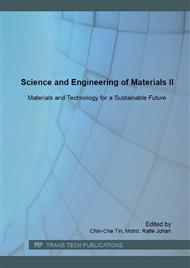[1]
Philippine Medical Device Market,. Last modified 2014. Accessed August 2014. http: /www. ita. doc. gov/td/health/philippines_meddev05. pdf.
Google Scholar
[2]
J. Hollinger, An Introduction To Biomaterials. 2nd ed. Boca Raton: CRC Press, 2011. Print.
Google Scholar
[3]
N. Pramanik, A. Tarafdar, and P. Pramanik, Capping Agent-Assisted Synthesis of Nanosized Hydroxyapatite: Comparative Studies of Their Physicochemical Properties,. Journal of Materials Processing Technology 184, no. 1-3 (2007): 131-138.
DOI: 10.1016/j.jmatprotec.2006.11.013
Google Scholar
[4]
S. Y. Ivanov, R. F. Mukhametshin, A. A. Muraev, and D. V. Solodkaya, Synthetic Materials Used for the Substitution of Bone Defects: Critical Review. Annals Of Oral & Maxillofacial Surgery.,. Oapublishinglondon. Com. Last modified 2013. Accessed August 2014. https: /www. oapublishinglondon. com/article/398.
DOI: 10.13172/2052-7837-1-1-398
Google Scholar
[5]
H. Wang, Y. Li, Y. Zuo, J. Li, S. Ma, and L. Cheng, Biocompatibility and Osteogenesis of Biomimetic Nano-Hydroxyapatite/Polyamide Composite Scaffolds For Bone Tissue Engineering,. Biomaterials 28, no. 22 (2007): 3338-3348.
DOI: 10.1016/j.biomaterials.2007.04.014
Google Scholar
[6]
M. Navarro, A. Michiardi, O. Castano, and J. Planell, Biomaterials in Orthopaedics,. Journal of the Royal Society Interface 5, no. 27 (2008): 1137-1158.
DOI: 10.1098/rsif.2008.0151
Google Scholar
[7]
A. Maho, S. Linden, C. Arnould, S. Detriche, J. Delhalle, and Z. Mekhalif, Tantalum Oxide/Carbon Nanotubes Composite Coatings on Titanium, and Their Functionalization with Organophosphonic Molecular Films: A High Quality Scaffold for Hydroxyapatite Growth,. Journal of Colloid and Interface Science 371, no. 1 (2012).
DOI: 10.1016/j.jcis.2011.12.066
Google Scholar
[8]
G. Singh, H. Singh, and B. S. Sidhu, Corrosion Behavior of Plasma Sprayed Hydroxyapatite And Hydroxyapatite-Silicon Oxide Coatings On AISI 304 For Biomedical Application,. Applied Surface Science 284 (2013): 811-818.
DOI: 10.1016/j.apsusc.2013.08.013
Google Scholar
[9]
K. R. Mohamed, H. H. Beherei, G. T. El Bassyouni, and N. El Mahallawy, Fabrication and Mechanical Evaluation of Hydroxyapatite/Oxide Nano-Composite Materials,. Materials Science and Engineering: C 33, no. 7 (2013): 4126-4132.
DOI: 10.1016/j.msec.2013.05.059
Google Scholar
[10]
S. Ramesh, C. Tan, C. Peralta, and W. Teng, The Effect of Manganese Oxide on the Sinterability of Hydroxyapatite,. Science and Technology of Advanced Materials 8, no. 4 (2007): 257-263.
DOI: 10.1016/j.stam.2007.02.006
Google Scholar
[11]
I. Sopyan, M. Mel, S. Ramesh, and K. Khalid, Porous Hydroxyapatite for Artificial Bone Applications,. Science and Technology of Advanced Materials 8, no. 1-2 (2007): 116-123.
DOI: 10.1016/j.stam.2006.11.017
Google Scholar
[12]
ASTM International. 2014. Standard Guide for Characterization of Ceramic and Mineral Based Scaffolds used for Tissue-Engineered Medical Products (TEMPs) and as Device for Surgical Implant Applications.
DOI: 10.1520/f2883
Google Scholar
[13]
ASTM International. 2014. Standard Test Method for in vitro Degradation Testing of Hydrolytically Degradable Polymer Resins and Fabricated Forms for Surgical Implants.
DOI: 10.1520/f1635-11
Google Scholar
[14]
J. Schiel and D. Hage, Density Measurements of Potassium Phosphate Buffer from 4 to 45 ˚C,. Talanta 65, no. 2 (2005): 495-500.
DOI: 10.1016/j.talanta.2004.06.029
Google Scholar
[15]
G. Tripathi and B. Basu, A Porous Hydroxyapatite Scaffold For Bone Tissue Engineering: Physico-Mechanical And Biological Evaluations,. Ceramics International 38, no. 1 (2012): 341-349.
DOI: 10.1016/j.ceramint.2011.07.012
Google Scholar
[16]
E. Gómez-Barrena, P. Rosset, D. Lozano, J. Stanovici, C. Ermthaller, and F. Gerbhard, Bone Fracture Healing: Cell Therapy in Delayed Unions And Nonunions,. Bone 70 (2015): 93-101.
DOI: 10.1016/j.bone.2014.07.033
Google Scholar


